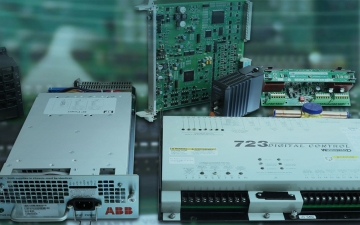-
Manufacturers
- ABB Advant OCS and Advant-800xA
- ABB Bailey
- ABB Drives
- ABB H&B Contronic
- ABB H&B Freelance 2000
- ABB Master
- ABB MOD 300 and MOD 30ML/MODCELL
- ABB Procontic
- ABB Procontrol
- ABB Synpol D
- Allen-Bradley SLC 500
- Allen-Bradley PLC-5
- Allen-Bradley ControlLogix
- Allen-Bradley CompactLogix
- Allen-Bradley MicroLogix
- Allen-Bradley PanelView
- Allen-Bradley Kinetix Servo Drive
- Allen-Bradley PowerFlex
- Allen-Bradley Smart Speed Controllers
- 2155 Series
- 3300 System
- 3500 System
- 991&990 Series
- 31000 & 32000 Series
- 21000 24701 & 164818 Series
- 177230 Series
- TK3 series
- 330500 Series
- 7200 Series
- GE 90-70 Series PLC
- GE PACSystems RX7i
- GE PACSystems RX3i
- GE QuickPanel
- GE VersaMax
- GE Genius I/O
- GE Mark VIe
- GE Series One
- GE Multilin
- 800 Series I/O
- Modicon 984
- Modicon Premium
- Modicon Micro
- Modicon Quantum
- Telemecanique TSX Compact
- Altivar Process
- Categories
- Service
- News
- Contact us
-
Please try to be as accurate as possible with your search.
-
We can quote you on 1000s of specialist parts, even if they are not listed on our website.
-
We can't find any results for “”.
Metallurgy

-
01. Optimizing PM Schedules Data-Driven Approaches to Preventative Maintenance
Moving away from fixed maintenance schedules is a significant operational shift. Companies now use data to guide their maintenance efforts. This change leads to greater efficiency and equipment reliability. The goal is to perform the right task at the right time, based on real information, not just the calendar.
What is Preventative Maintenance (PM) and Why Optimize It?
Preventative maintenance is a proactive strategy. It involves regular checks, servicing, and repairs on equipment. The main purpose is to find and fix small issues before they cause major breakdowns or failures. Optimizing this process is critical for modern operations.
A traditional PM program follows a fixed schedule, like monthly checks. This method is better than simply waiting for a machine to fail. However, a fixed schedule does not consider the actual condition of an asset. A machine might get serviced when it is running perfectly fine. Another machine might fail just before its scheduled check. Optimization moves maintenance from a time-based trigger to a condition-based one. Using real data to schedule work improves operational efficiency and avoids unexpected downtime.

he Limitations of Traditional Time-Based PM Traditional PM relies on the calendar, but this approach has serious drawbacks. These limitations create inefficiencies and expose facilities to unnecessary risks, prompting a need for a smarter maintenance strategy. -
02. Optimizing PM Schedules Data

The core problem with time-based maintenance is its reliance on guesswork. Schedules are often set based on averages or manufacturer suggestions, not on an asset's real-world performance. This leads to two major problems. First, over-maintenance occurs when technicians service equipment that is in perfect working order. This wastes labor hours, consumes spare parts needlessly, and increases the chance of human error during reassembly. Second, under-maintenance happens when a machine fails before its next scheduled checkup. Calendar-based plans often miss failures caused by operational stress or environmental conditions because they are designed to catch only age-related wear.
Introducing Data-Driven PM: The Future of Maintenance
Data-driven PM is the modern solution to the problems of traditional maintenance. It uses technology to collect and analyze operational data, allowing for smarter and more effective scheduling decisions.
This advanced approach transforms maintenance from a rigid, scheduled activity into a dynamic, responsive process. The system works through a few key technologies. The Internet of Things (IoT) involves placing sensors on equipment to collect real-time information. These sensors monitor factors like temperature, vibration, and pressure. Then, artificial intelligence (AI) and machine learning algorithms analyze this stream of data. The software identifies patterns and subtle changes that indicate a potential failure in the future. Maintenance is then scheduled precisely when it is needed, just before a problem develops.
Key Data Points for Smarter PM Scheduling
A successful data-driven PM program depends on collecting the right types of data. Different data streams provide unique views into equipment health, and combining them creates a comprehensive picture for accurate predictions. -
03. Preventative Maintenance
Products must be unused, in original packaging, and include all accessories. To initiate a return, please contact our customer service team for a Return Authorization Number (RAN). Non-returnable items include customized, used, or consumable products. Defective or incorrect items can be returned for a full refund or replacement at no extra cost. Customers are responsible for return shipping costs, unless the product is defective. Refunds are processed within 7-10 business days after inspection.
-
Optimizing PM Schedules Data-Driven Approaches to Preventative Maintenance
-
Optimizing PM Schedules Data
-
Preventative Maintenance

Hot recommendation

Need an automation or control part quickly?
- About us
- Our Team Contact Us 20 Years in Business About us
- Q&A
- Policies How to order Part status information Shiping method Return Policy Warranty Policy payment terms
- Asset Recovery
- We Buy Your Equipment. Industry Cases
- ADDRESS
-
 32D UNITS,GUOMAO BUILDING,NO 388 HUBIN SOUTH ROAD,SIMING DISTRICT,XIAMEN
32D UNITS,GUOMAO BUILDING,NO 388 HUBIN SOUTH ROAD,SIMING DISTRICT,XIAMEN
Copyright Notice © 2004-2024 amikong.com All rights reserved
Disclaimer: We are not an authorized distributor or distributor of the product manufacturer of this website, The product may have older date codes or be an older series than that available direct from the factory or authorized dealers. Because our company is not an authorized distributor of this product, the Original Manufacturer’s warranty does not apply.While many DCS PLC products will have firmware already installed, Our company makes no representation as to whether a DSC PLC product will or will not have firmware and, if it does have firmware, whether the firmware is the revision level that you need for your application. Our company also makes no representations as to your ability or right to download or otherwise obtain firmware for the product from our company, its distributors, or any other source. Our company also makes no representations as to your right to install any such firmware on the product. Our company will not obtain or supply firmware on your behalf. It is your obligation to comply with the terms of any End-User License Agreement or similar document related to obtaining or installing firmware.




